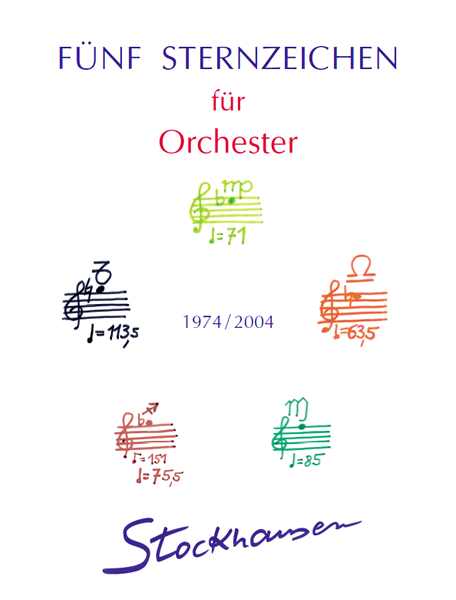
In fact, Stockhausen’s ideal presentation for Klang was in a museum with each Hour sounding simultaneously from separate galleries.
#STOCKHAUSEN TIERKREIS SCORE CRACKED#
The trios are parts of a whole, as if an orchestra were cracked into pieces and playing the same piece in separate rooms. They are blurred together, perhaps as if one were asleep. The seven trios of Klang (Hours 6-12), are not meant to be discrete segments of the cycle. Since the 1st Hour of Klang, Stockhausen has been slowly breaking down our ideas about how time passes. There are moments of stunning beauty, as well as a gauzy sense of place and time. The resulting counterpoint is aleatoric, intermittently frustrating, and beguiling. The 6th Hour, Schönheit (Beauty, 2007) begins with the flute playing the 1st moment of Harmonien, while the trumpet plays the 2nd, and the bass clarinet plays the 3rd.
#STOCKHAUSEN TIERKREIS SCORE SERIES#
The second phase of Klang is a series of acoustic trios based on the music of Harmonien. Many people felt that Stockhausen knew his time on Earth was coming to an end. The next year, which was the only one remaining in his life, proceeded at a breakneck pace that no one around him had seen since the late 1960s rock star phase of his career. In 2006, he turned 78, and he would need over a decade to finish Klang at its established pace. In the first of the three versions of Harmonien, Stockhausen asked the bass clarinetist to move to a new spot on the floor for each of the 24 tempi in the piece.īy this point in Klang, nearly three years had passed in Stockhausen’s life since the completion of Licht, and he had composed less than a quarter of the 24 pieces he intended for the cycle. Languorous melodies are immediately echoed by faster repetitions of the same notes in displaced octaves, creating the illusion of harmony. In the 5th Hour, Harmonien (Harmonies, 2006), a solo performer cycles melodic material through 24 iterations. Perhaps because 24 panels would start to resemble one of Harry Partch’s marimbas, the door here only has 12 panels, 6 per leaf. Stockhausen prescribes 14 different moods for his efforts : excited, angry, impatient, humorous, etc. The percussionist tries to open the Door (shipped from Atlanta for these performances), and the poor fellow seems to have no luck. Himmels-Tür (Heaven’s Door, 2006), the 4th Hour, is the most theatrical piece in the cycle. Some durations are governed by the length of the pianist’s breath. Some pieces are governed by the resonance of the instrument, and the pianist cannot move on to the next sound until the current one has faded away. Like Freude, the piece is highly variegated. The 3rd Hour, Natürliche Dauern (Natural Durations, 2006), is a cycle-within-a-cycle : 24 piano pieces for the 24 hours of the day. The end result is a tour de force that feels like it has exhausted the capabilities of the harp. Each moment of the score takes a different approach to the 24 lines of the Latin hymn “Veni Creator Spiritus”. Their virtuoso performance is structured in 24 moments. Slower tempi have darker timbres, and faster tempi have clearer ones.įreude (Joy, 2005), the 2nd Hour, is a completely different sonic world populated by two singing harpists. On top of all that, with each new tempo, Stockhausen requires a new timbre from the organ : 24 in total. In addition to doing things like playing 40 beats per minute in his right hand against 75 bpm in his left, he must occasionally accompany two singers, as well as strike a small percussion battery. His hands rarely play in the same tempo, and no tempo is sustained for very long. In the 1st Hour of Klang, Himmelfahrt (Ascension, 2005), the organist is overtasked.

In 1977 came Sirius, his music for the seasons, and from that year until 2003, he composed Licht (Light) for the seven days of the week.

Had Stockhausen lived to complete Klang, he had vowed to next compose music for the minute, then for the second, and so on, continuing the decades-long project of diminution that began in 1975 with Tierkreis (Zodiac), his music for the year.

Each piece functions as a microcosm of the whole, containing 24 moments. The first five Hours of Klang are highly eclectic, bearing little resemblance to each other.

In the early stages of the project, Stockhausen set each moment of Klang apart. He envisioned Klang as a collection of moments, much like the hours in a day.


 0 kommentar(er)
0 kommentar(er)
